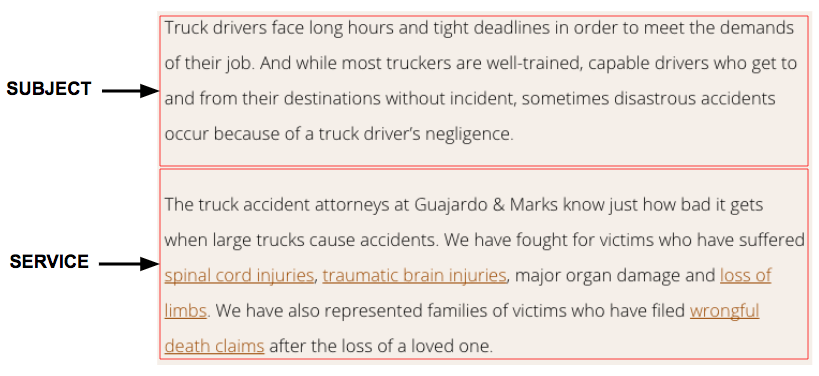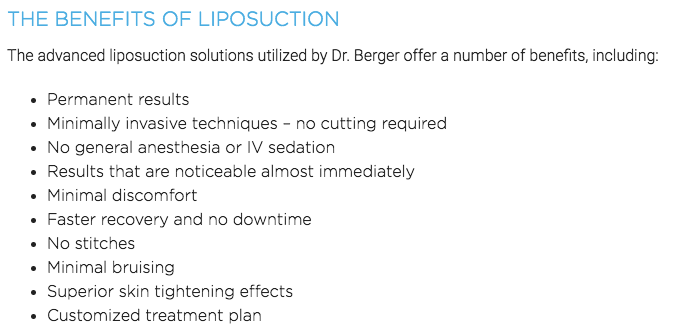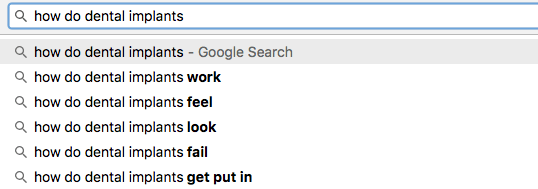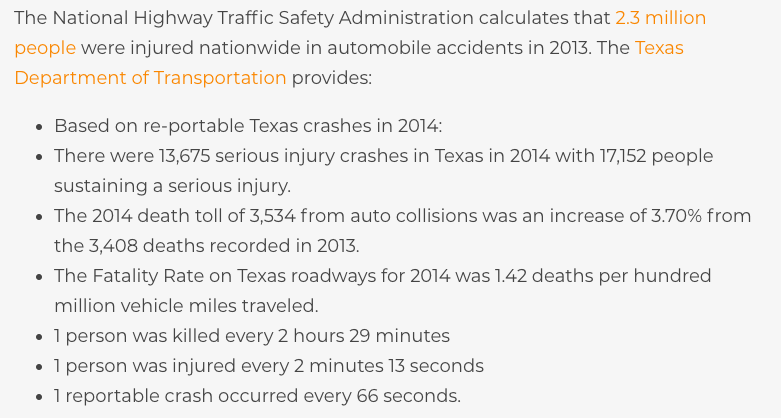Landing pages are important for any website because they are a visitor’s first impression of the business itself. Having a great landing page is the difference between engaging a visitor or driving them away. But landing pages also play an important role in getting a visitor to your site in the first place. This is because search engines are constantly trying to guess whether or not a page will be valuable to potential searchers. Here’s what Google has to say about the algorithms they use for ranking pages:
“These algorithms analyze hundreds of different factors to try to surface the best information the web can offer, from the freshness of the content, to the number of times your search terms appear, and whether the page has a good user experience.”
The first two points are fairly self explanatory. Content should be “fresh,” meaning that it should be up-to-date and accurate. You should also utilize target search terms throughout the landing page because this is the most obvious way to send signals regarding your topic. But what exactly is a “good user experience”? How does an algorithm judge whether or not a human will find a certain webpage useful?
The answer is, it’s a secret; something that the search engines don’t tell the general public. However, there are ways in which we can study their results to get an idea of how search engines value certain page characteristics. One such tactic is to look at pages that are successfully ranking well and analyze their content.
Rising to the Challenge

For this exercise, we will be looking at pages that rank well for some of the most competitive keywords in the United States. We’ll be breaking down the ideal SEO-friendly geographic service pages based on the most common features of these pages. By looking at their strategies for success, we can gain valuable insights to help us beat competitors.
Introducing the Topic
Having a concise intro demonstrates your expertise as an author. People have short attention spans, so your intro not only has to clearly address the topic right away, but also be interesting enough to make readers want to stay on your page. You want to assure the reader that they have come to the right place for the information they are seeking.
Ideally, you want a two paragraph introduction with the first paragraph covering the subject of your service. If you are a personal injury lawyer, talk about the injustice of a debilitating injury. If you are a bed bug exterminator, talk about the scourge of bed bugs. This is your subject. Next, address the relationship you or your business has with this subject. This is your service. Below is a great example of an intro from the top ranking page for the search term “Dallas truck accident lawyer”:

Your Service
Next you will want to cover what is provided with the service you are advertising. What is it that you will be doing for your potential client? How do you define the process? This section gives you an excellent opportunity to utilize external links to noteworthy sites. For instance, if you are a divorce lawyer for a certain state, explain how a “divorce” is defined by the laws of your state with a link to the official legal code. Check out this example from the top page for “Los Angeles divorce lawyer”:

Why send a potential customer or client away from your site? Some studies have shown that external links to high-authority external sites can actually boost your rankings. Use authoritative sites to establish your own expertise on the topic at hand.
What you Bring to the Table
Next you want to address the reasons why a client should want to use this service. What will they gain or what problem will be solved after they use this service? What makes your unique version of the process different than the competition? Here’s an example from the top ranking page for the search term “Liposuction Los Angeles”:

Take notice of how the above list is structured. We found that 81% of the high-ranking service pages we investigated for this post used HTML lists. These lists are successful because they:
- Sum up facts succinctly
- Are easy to read
- Demonstrate the relationship between items
- Allow information to stand out
The benefits of your service are the meat of your sales pitch. If you don’t clearly emphasize to your readers what they will gain from your service, you will lose them to a competitor.
Frequently Asked Questions
So you’ve addressed the problem and how you will solve it. What’s next? When looking at top ranking service pages, you will find that they usually cover far more than the two topics we just discussed. In fact, many of the top ranking service pages weigh in at around 1000 words. How do you fill that space? Answer questions!
Think about it. More than anything else people are turning to search engines for solutions to their problems. Every industry, geography, and service has their own niche with potential high-volume questions that people are asking over and over again, also known as “frequently asked questions”, or FAQs. And the great news is that Google makes these questions available for free based on their Instant Autocomplete feature. Let’s take the example of writing a “Dental Implants” page for a Dentist. Think about what you would type into Google if you were someone researching the topic. Just like that, you have a list of great questions to address on your page:

These prediction results come from real searches, so addressing them on your service page will be valuable to whoever lands on your site.. Here’s an example of how a high ranking page for “Botox Miami” utilizes FAQs within a collapsable menu:

Topical Facts and Statistics
Many of the highest quality service pages also function as a resource page on the subject. Take a look at the top ranking page for “Bed Bug Exterminator NYC”:
 Disgusting, but effective. This written content further establishes the page as a clear resource on the topic. Want bonus points? Find a way to incorporate location-specific statistics and information. Check out a high performing page for “Houston Car Accident Lawyer”:
Disgusting, but effective. This written content further establishes the page as a clear resource on the topic. Want bonus points? Find a way to incorporate location-specific statistics and information. Check out a high performing page for “Houston Car Accident Lawyer”:

This section utilizes not only localized car accident statistics, but it even puts them in list form and links out to federal and state websites. Multiple wins.
Bringing Everything Together

Your page should conclude with strong call to action giving the reader an opportunity to contact you to learn more or to schedule an appointment. Include a clickable phone number, an external link to your Google Business Profile page for easy driving directions, and a link to a contact page for users to complete your online form.
We also highly recommend displaying at least one review for your service along with a link to a dedicated reviews page. One study showed that 88% of consumers trust online reviews as much as personal recommendations.
As always, focus on usability. Make sure that there is an efficient way for the reader to complete the action that you desire whether that be reaching out for more information or viewing social proof of your work.
The Technical Details
Now that you’ve constructed your page, let’s look at some of the more detailed things to check off before hitting publish:
Should you link to internal pages?
When writing your content, it’s beneficial to utilize internal linking, which allows you link to other pages on your site such as blog posts or an FAQ page so that if the reader wants to learn more on that subject, they can click on that internal link and find more information on a different page, all while remaining on your site. This not only demonstrates your expertise on the subject or service at hand, but also the related topics.
It’s crucial to ensure that internal links create a two-way path, so if your service page links out to a related blog post, make sure that the corresponding blog most links back to the correct service page. Robust internal linking demonstrates organization and usefulness to search engines, helping your pages rank higher in results.
How many times should you use an exact keyword on a page?
SEO best practices recommend at least one use of your exact keyword on the page. So, if you are targeting “flood restoration in Chicago” it would be ideal to use that phrase, naturally, somewhere on the page. The main rule to keep in mind here is not using the phrase too much. Stuffing your page full of “food restoration in Chicago” and “Chicago flood restoration” is an easy way to get your rankings tanked for keyword stuffing.
How many times should you use the geographic location?
If your market is Seattle, you are safe to mention the city name and surrounding cities throughout the page. Just be sure that, once again, geographic locations are brought up naturally. Listing out every county in Western Washington will only help in getting you flagged by search engines.
How many times should the subject be mentioned?
This is where things get fun. Let’s loop back to the beginning of the article where we discussed the “Subject” and “Service” of a page and identifying exactly what your business is related to. This information can be used to generate what we call Latent Semantic Indexing (LSI) keywords. These are keywords which are often found in other high-ranking pages about your subject. If we were talking about a “Phoenix plumber”, these keywords would be phrases like “plumbing in your home”, “plumbing service”, “plumber rates”, and “drain cleaning”.
What’s great about these keywords is that, as long as they are being used naturally, you are highly encouraged to use them all over your page. This top ranking page for “Chicago medical malpractice lawyer” has some form of “medical malpractice” term taking up approximately 5.6% of the page’s written words. These are terms like “medical malpractice lawsuits” and “medical malpractice claims”. This top page for the search term “water damage Clearwater FL” clocks in at around 2.7% of the page’s written words being used for phrases like “water damage cleanup” and “flood and water damage”. LSI keywords in natural settings allow you to send strong signals about your page’s intention without worrying about keyword stuffing.
Make It Your Own

While this article lays out a template for utilizing best practices in geo-specific service landing pages, it is by no means a rulebook. External links can be used in your introduction and bullet point lists can make a great addition to your conclusion under the right circumstances. Some pages rank with only 400 words of copy. There are no hard and fast rules for getting to page one besides always focusing on what will serve your website visitors the best.
Every service is different, so experimenting with the tools and resources you have available is essential to finding what is most useful to a visitor (and, by proxy, a search engine). Also be sure to always follow SEO fundamentals for your pages. Your content won’t be able to shine without proper title tags, meta descriptions, header tag usage, and beautiful images with properly written alt text. Off the site, don’t forget about your small business digital marketing fundamentals and the importance of external links. When you’re ready to boost your page even more, videos and infographics are also traits of successful local service landing pages.
Want to learn even more? V Digital Services provides search engine optimization and digital marketing solutions for local service companies in a number of fields. Let us help you develop a winning online marketing strategy today.


 PREVIOUS
PREVIOUS
En California es solo una teoría el decir: el que pega paga, pues California se rige por una norma que comparte la responsabilidad en un accidente y lo más seguro es que siempre haya responsabilidad repartida en las dos partes.